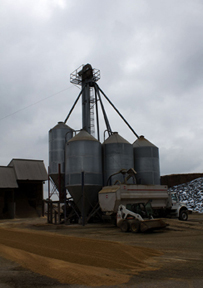 We drove through central and southern Illinois on the way to and from the joint American Association of Bovine Practitioners and National Mastitis Council meeting in St. Louis, Mo. Combines, grain carts, and semi-trucks are in the fields collecting this year's harvest. That reminded us of some grain bin management tips, compiled by Joe Harner.
We drove through central and southern Illinois on the way to and from the joint American Association of Bovine Practitioners and National Mastitis Council meeting in St. Louis, Mo. Combines, grain carts, and semi-trucks are in the fields collecting this year's harvest. That reminded us of some grain bin management tips, compiled by Joe Harner. Harner is an Extension Engineer for Grain and Livestock Systems at Kansas State University. He provided his top 10 in 2005, and we think they are still helpful today:
1. Make sure grain facilities are cleaned inside and outside. Any place an insect can live must be cleaned. Places where physical cleaning is not possible must be cleaned using chemicals.
2. Cool your grain as quickly as possible. The recommended temperature of cooled grain is 70° F in warmer months and 35° to 40° F in cooler months.
3. Be aware of incoming moisture, and remember that aeration fans are not intended to dry grain but to cool it. High-moisture grain entering storage can create problems.
4. Adjust harvesting and handling equipment to decrease the amount of broken kernels and unwanted material. The more broken kernels, the more surface area is exposed for insects to nibble. Equipment, excessive handling, and dry grain are the three leading causes of broken kernels.
5. Clean grain is important. Weedy material usually has higher moisture content than grain and may accumulate in isolated pockets which can interfere with aeration, making areas more difficult to cool.
6. Monitor the temperature, moisture, and odor of stored grain with scheduled inspection times. Inspection should be every two weeks once grain and outdoor air temperatures are above 45° F.
7. Pay attention, and be observant because most problems can be fixed early. While odor is a good indicator of grain spoilage, moisture may be another good indicator. Slimy grain and drip spots on the underside of a roof are indications of too much moisture.
8. Safety first. Safety should be first and foremost on the minds of everyone working near grain storage facilities. Use caution, and follow all guidelines when using chemicals. For safety reasons, have at least two people present when sampling grain bins.
9. Have a marketing plan, and use it to help develop a management strategy to maintain stored grain quality. During warmer weather months, it may be necessary to rewarm the grain to prevent moisture migration due to temperature differences within a grain bin.
10. Be prepared to make quick decisions about grain storage problems once they are detected. To prevent further damage of stored grain that is heating, it should be cooled, turned, or marketed as soon as possible.
Click here for the full article on grain storage at the Kansas State website.








